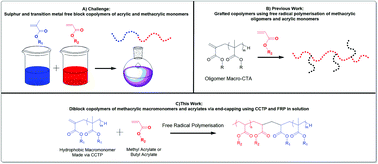Controlled synthesis of methacrylate and acrylate diblock copolymers via end-capping using CCTP and FRP†
Abstract
Scalable methods of producing functional materials is of importance. Herein, we report the use of free radical copolymerisation of ω-unsaturated methacrylic macromonomers, as derived from catalytic chain transfer polymerisation (CCTP), with acrylic monomers in solution leading to block copolymers by varying the nature of the macromonomer. We demonstrate the effect that varying the molecular weight and ester side chain length of macromonomer from CCTP, has on the polymerisation leading to either graft or diblock copolymers. DOSY NMR, MALDI-ToF/ToF MS has allowed for the exploration of the extent to which varying the concentration of macromonomer has on the products formed. Importantly, during the successful synthesis of acrylic and methacrylic diblock copolymers with broad dispersities of each block, full consumption of the macromonomers was observed.



 Please wait while we load your content...
Please wait while we load your content...